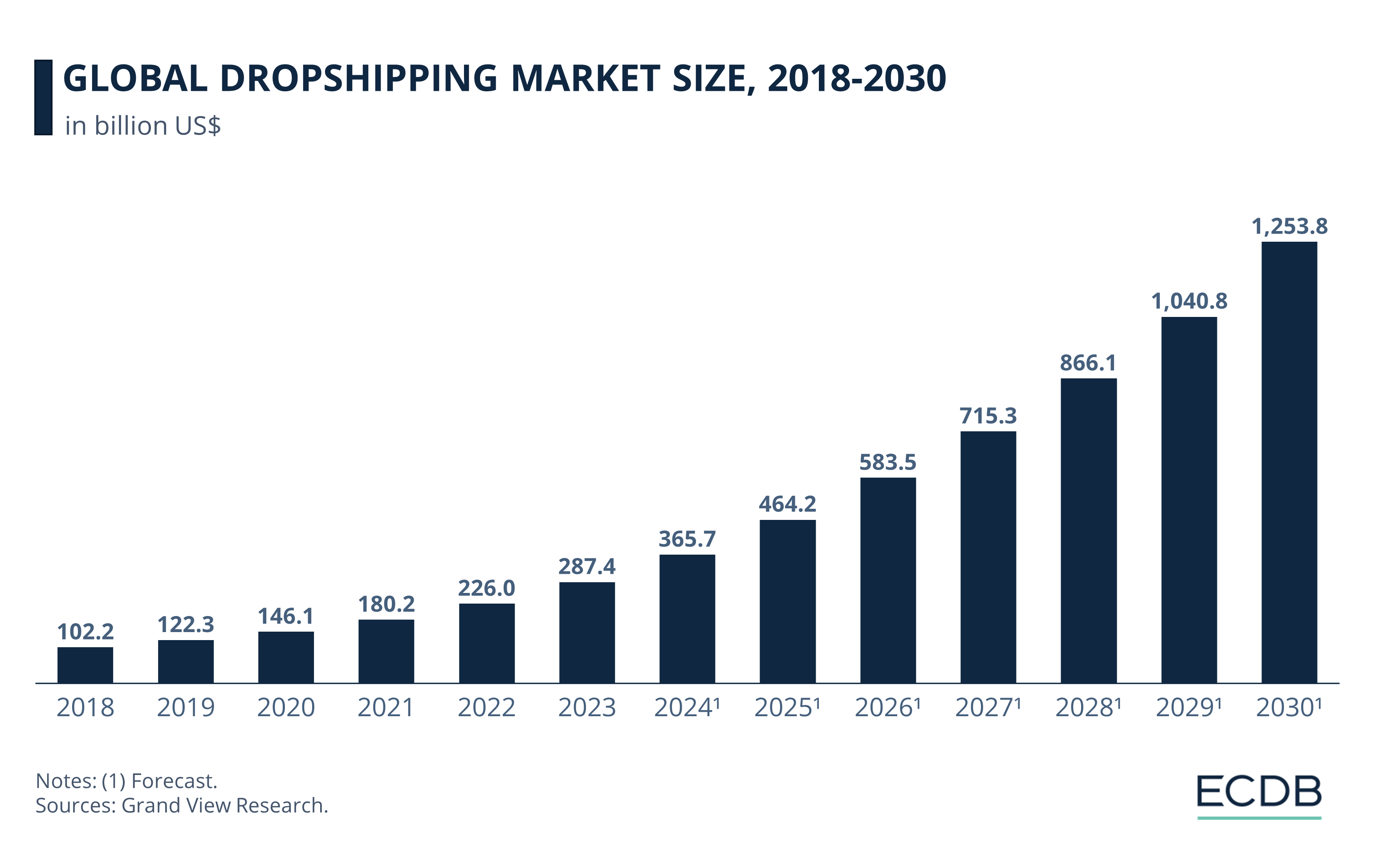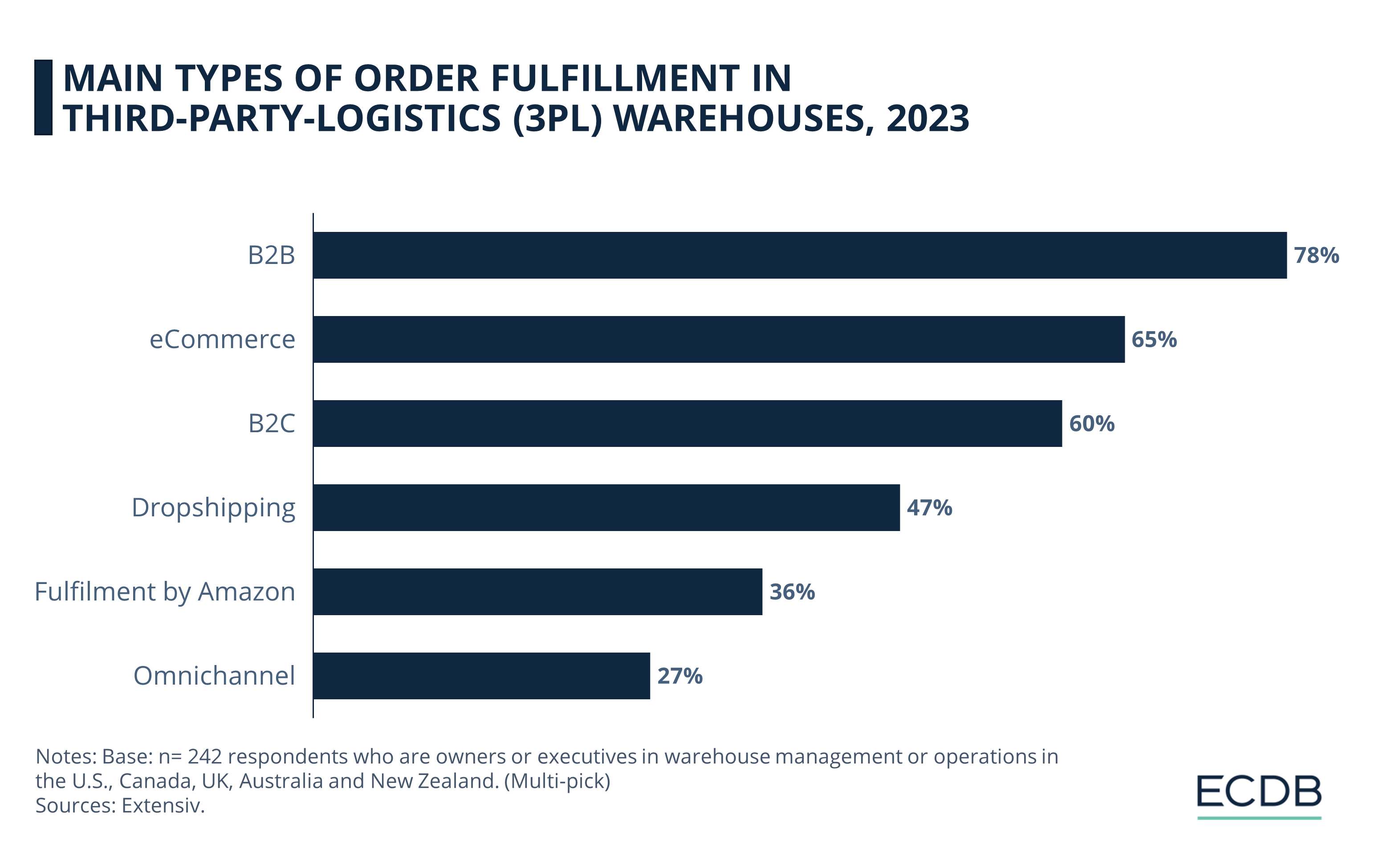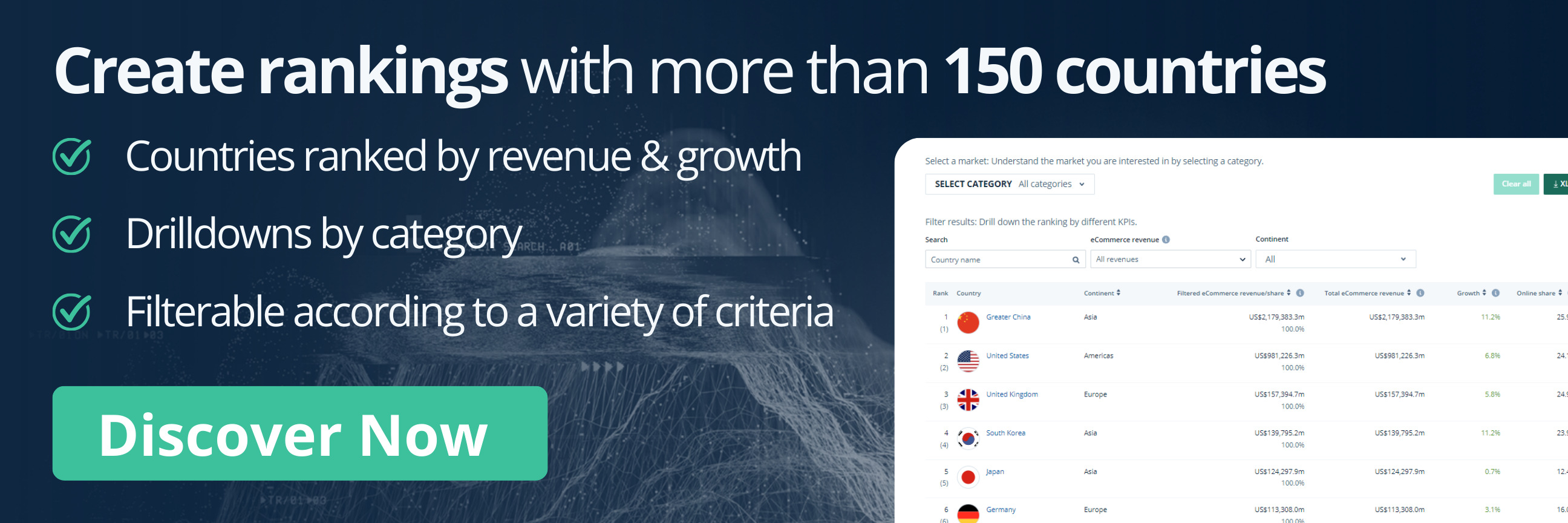eCommerce: Dropshipping
What is Dropshipping and How Does It Work?
Dropshipping is a word we hear a lot in the eCommerce space, but do you really know what it is? We take a look at its meaning, development, pros and cons.
Article by Cihan Uzunoglu | July 12, 2024
Dropshipping: Key Insights
Dropshipping Apps: Different dropshipping apps offer features like bulk order processing, real-time inventory updates, custom branding, advanced analytics, and integration with platforms like Shopify and WooCommerce to streamline eCommerce operations.
Market Growth: The global dropshipping market was valued at US$102 billion in 2018, grew to US$287 billion in 2023, is expected to reach US$365 billion this year, and is projected to hit US$1.25 trillion by 2030.
Building a Business: To build a dropshipping business, focus on niche selection, competitor research, reliable suppliers, online store creation, marketing, and analytics, while prioritizing product quality, profit margins, and shipping reliability.
Pros and Cons: Dropshipping offers low overhead and startup costs, flexibility, and scalability, but faces high competition, low profit margins, quality control issues, branding limitations, and complex customer service challenges.
Alternatives: For eCommerce businesses not suited for dropshipping, alternatives like third-party fulfillment (3PL), creating branded products, and affiliate marketing provide advantages such as greater control over logistics, enhanced brand identity, and minimal startup costs.
You've probably heard about dropshipping. But have you ever wondered how some online stores sell a huge range of products without ever touching them? Imagine running an online store without the headaches of inventory management. But how does it actually work?
We dive into the concept and look at the pros and cons of dropshipping. Read on to learn the details of dropshipping, discover the best apps to streamline operations, and decide if this model is right for your business.
What is Dropshipping?
Dropshipping is an eCommerce fulfillment model where online retailers sell products without keeping them in stock.
Instead, they purchase items from third-party suppliers who directly ship them to customers. This eliminates the need for inventory storage and shipping logistics.
How Does Dropshipping Work?
Dropshipping outsources fulfillment to third-party suppliers. The process involves:
Agreement and Setup: Retailers partner with suppliers for sourcing, fulfillment, and shipping.
Order Placement: Customers buy products through the retailer’s website.
Order Notification: Retailers confirm orders with customers.
Order Forwarding: Details are sent to suppliers via automated systems.
Fulfillment: Suppliers prepare, package, and ship orders.
Delivery: Customers receive products directly from suppliers.
Is Dropshipping Legal?
Dropshipping is legal if retailers comply with business regulations, tax laws, and supplier terms. Issues arise with trademark or IP (intellectual property) infringements, making supplier selection crucial.
Like this insight? It is based on our regularly updated rankings. With our retailer and country rankings, you can learn valuable information about your specific market. Our product category rankings and benchmarks allow you to see where various businesses are currently evolving. This information can aid in your decision-making, whether you are a business developer, shop owner, or CEO of a large eCommerce brand. Stay a step ahead of the market with ECDB.
Best Dropshipping Apps
Dropshipping platforms are comprehensive services that often provide a range of functionalities, including supplier directories, product sourcing, and order fulfillment management. Apps, on the other hand, are typically integrated with eCommerce platforms like Shopify or WooCommerce and focus on specific tasks such as automating order processing, syncing inventory, and facilitating product imports.
Here are 9 dropshipping apps (in no particular order), each offering unique features to streamline business operations:
1. DSers
DSers connects Shopify stores with AliExpress, enabling users to place hundreds of orders to AliExpress in seconds. The app offers a bulk order feature, significantly reducing processing time. It also supports multiple store management, making it ideal for entrepreneurs managing more than one online store.
2. Zendrop
Zendrop provides a catalog with over a million products and fast delivery times, offering automated order fulfillment and real-time tracking. It also allows for custom branding on packaging, enhancing the customer experience.
3. Spocket
Spocket connects users with suppliers in the U.S., Europe, Brazil, and India. It offers real-time inventory updates and branded invoices, enhancing stores’ professional appearance and building customer trust.
4. Printify
Printify lets users create and sell custom products without handling inventory. With a network of global print providers, Printify ensures quick delivery. It also allows for custom designs on items such as t-shirts, mugs, and phone cases.
5. AutoDS
AutoDS integrates with suppliers like AliExpress and Amazon, automating dropshipping and print-on-demand processes. The app provides advanced analytics to help track sales and optimize listings, along with price monitoring to ensure competitive pricing.

6. Teelaunch
Teelaunch is a print-on-demand app that works seamlessly with Shopify, allowing store owners to create products such as t-shirts, mugs, and phone cases.
It supports custom branding options and provides reliable global shipping from multiple production facilities, ensuring faster delivery times and enhanced customer satisfaction.
7. CustomCat
CustomCat offers a comprehensive print-on-demand service with over 350 product templates, including apparel, drinkware, and home decor. Integrating with platforms like Shopify and WooCommerce, it automates the order process from design to delivery.
CustomCat features fast fulfillment, often shipping orders within 2 business days, and offers a subscription plan that boosts profit margins.
8. Retail Express
Retail Express integrates with Shopify, offering a complete POS and eCommerce solution. It features advanced inventory management, real-time stock updates, and efficient order fulfillment.
Supporting omnichannel operations like Click & Collect, Retail Express is perfect for retailers wanting to unify in-store and online operations, ensuring a smooth customer experience and optimized performance.
9. Oberlo
Oberlo is exclusively for Shopify, allowing users to import products from AliExpress and fulfill orders directly. It features bulk order processing, automated inventory and pricing updates, and multilingual support.
With real-time tracking, multiple staff accounts, and various pricing plans, Oberlo is ideal for those looking to start or scale their dropshipping business efficiently.
Dropshipping Market Size:
US$1 Trillion by 2029
The global dropshipping market has been on the rise and is expected to continue growing. Here's the revenue development of the global dropshipping market:

With revenues of US$102.2 billion in 2018, the global dropshipping market rose to US$146.1 billion by 2020.
Last year's US$287.4 billion is anticipated to hit US$365.7 billion by the end of 2024.
Forecassts show that the market will continue to grow, reaching the US$1 trillion mark by 2029.
Key Roles in the Dropshipping Model
Several key roles are essential to the dropshipping model:
Seller of Record
Seller of record (SoR) is responsible for selling products directly to consumers. They set prices, record revenue, and handle sales tax, even if fulfillment is managed by third-party suppliers. Platforms like Amazon require sellers to maintain this role to comply with dropshipping policies.
Manufacturers
Manufacturers produce goods for wholesale and retail markets. While direct purchases may require large minimum orders, some manufacturers offer dropshipping services, allowing retailers to access their products without inventory management.
Wholesalers
Wholesalers act as intermediaries, buying products in bulk from manufacturers and selling them to retailers at a markup. Although they typically do not sell directly to consumers, wholesalers may provide dropshipping services, leveraging their distribution networks for retailers.
Dropshipping Product Ideas
Although dropshipping can be done for a variety of products, some categories are more common than others. These include:
Tote bags supporting charitable causes.
Novelty t-shirts.
Humorous coffee mugs.
Motivational bookmarks.
Affordable watches or jewelry.
Customizable marketing merchandise like shirts, bags, mugs, and pens featuring brand logo.

How to Build a Dropshipping Business
in 2024
When launching a dropshipping business, whether experienced in online ventures or new to eCommerce, consider this step-by-step guide to setting up and expanding the operation:
Choose a Niche: Focus on a specific niche to differentiate the brand and target the ideal customer base effectively.
Research Competitors: Assess the competition in the chosen niche to gauge market saturation and identify opportunities.
Select a Reliable Dropshipper: Partner with reputable suppliers known for reliable order fulfillment, timely delivery, and quality products. Consider sourcing directly from manufacturers for better control and pricing.
Build an Online Store: Create an eCommerce website using platforms like Shopify, WordPress, or Squarespace. Integrate with the chosen dropshipper for seamless order management.
Drive Sales with Marketing: Use paid advertising on search engines and social media to attract customers. Platforms such as Amazon offer tools to enhance product visibility and sales.
Optimize and Analyze: Utilize analytics tools to monitor sales trends, understand customer preferences, and optimize product listings for improved search rankings and conversion rates.
When choosing a dropshipper, it is important to prioritize factors such as product quality, profit margins, shipping reliability, and return policies. Businesses should start with minimal inventory investment and focus more on website development, marketing efforts and customer acquisition. Regular testing of new products is another key component to gauge market interest and strategically expand product offerings.
Pros and Cons of Dropshipping
Dropshipping has its advantages and disadvantages. Whether it suits a business depends on specific goals and circumstances. Here are some pros and cons to consider:
Pros of Dropshipping
Low Overhead Costs: No need to store or ship products significantly lowers overhead expenses. This way businesses can allocate these expenses into other channels.
Minimal Starting Costs: Starting a dropshipping business requires minimal investment. Entrepreneurs can start without investing in facilities or resources to process orders, making it accessible for those with limited capital.
Reduced Risk and Flexibility: Without the need to purchase inventory upfront, there's less risk of losing money due to unsold merchandise or over-ordering. A dropshipping business can be operated from anywhere with an internet connection, allowing for a flexible work environment.
Multichannel Selling and Scalability: Dropshipping allows for sales on personal websites, Amazon, or social media channels simultaneously. Leveraging suppliers makes it easier to handle more orders without the need to manage additional inventory.
Wide Variety of Products and Testing Flexibility: Without needing to pre-purchase inventory, a broad range of products can be offered, adapting quickly to market trends. Dropshipping also enables testing different products to determine what sells best without risking investment loss.

Cons of Dropshipping
High Competition and Low Profit Margins: The low cost and investment to start a dropshipping business make it a highly competitive field. Intense competition often leads to price wars, which can reduce profit margins.
Quality Control and Branding Limitations: Not handling products directly can make ensuring product quality challenging. Products may not be unique or distinguishable from competitors, making brand differentiation harder.
Fulfillment Timeline and Inventory Management Issues: Lack of control over the fulfillment process can result in delays, affecting customer satisfaction. Real-time stock updates may not be possible, leading to potential out-of-stock issues.
Limited Special Offers and Supplier Errors: There may be limitations in running special promotions or offers due to reliance on suppliers. Mistakes by suppliers, such as botched orders or poor packaging, reflect on the business and can harm its reputation.
Complex Customer Service: Even though suppliers handle fulfillment, the responsibility for customer service and managing any issues arising from the dropshipping process falls on the business, which can be time-consuming and challenging.
Alternatives to Dropshipping
If dropshipping is not the right fit for an eCommerce business, there are several alternatives for outsourcing fulfillment. Here are a few options to consider:
Third-Party Fulfillment
Instead of dropshipping, some sellers purchase products in bulk and use a third-party fulfillment (3PL) service to store items, pick and pack orders, and ship them to customers.

While B2B is the main type of order fulfillment in 3PL warehouses, dropshipping is the 4th most popular one, with 47% of surveyed respondents agreeing.
Dropshipping relinquishes control over inventory and shipping to suppliers, limiting customization and quality oversight compared to 3PL. While dropshipping has lower upfront costs, it can lead to narrower profit margins due to supplier fees and shipping costs.
In contrast, 3PL offers greater control over logistics, faster shipping, scalability, branded packaging, and improved customer satisfaction.
Branded Products
Creating branded products can help a business grow and stand out from competitors. Selling branded products allows differentiation from other eCommerce brands, builds customer loyalty by offering a unique online experience, and establishes a memorable brand identity.
This increases brand recognition, aiding the launch of future products. Businesses can work with dropshipping suppliers to add individualized touches like special packaging and branding. Alternatively, it is also possible to have a manufacturer produce branded products in bulk and use FBA (Fulfillment by Amazon) for distribution.
Affiliate Marketing
Affiliate marketing is a different business model worth considering for those preferring to avoid managing customers, orders, and returns. Affiliate marketers promote products for eCommerce retailers and earn a commission when a customer purchases through a unique referral link.
This model offers minimal startup or overhead costs, the opportunity to build an audience, and earnings from sales generated through promotional efforts. While it focuses on advertising rather than retail, it can be a viable alternative for those looking to monetize their online presence without handling physical products.
Dropshipping: Closing Thoughts
The dropshipping market has evolved significantly, driven by advances in eCommerce and changing consumer behavior. The COVID-19 pandemic accelerated the shift to online shopping, increasing the popularity of dropshipping.
Over the next 5 to 10 years, we can expect increased automation, better integration with AI for inventory and customer service, and possibly stricter regulations. As technology advances and consumer expectations rise, dropshipping will have to adapt to provide faster shipping, improved quality control, and a more personalized experience.
While competition remains fierce, dropshipping's flexibility and low overhead ensure its continued relevance in the online shopping space.
Sources: Amazon: 1, 2, Shopify: 1, 2, 3, BigCommerce, Forbes, State of Michigan, ShipBob, Extensiv, Grand View Research

Click here for
more relevant insights from
our partner Mastercard.
Related insights
Deep Dive
The Global B2B eCommerce Market: Why It Is Beneficial to Sell to Other Businesses
The Global B2B eCommerce Market: Why It Is Beneficial to Sell to Other Businesses
Deep Dive
eCommerce in Indonesia: Revenues Projected to Cross US$100 Billion in 2025
eCommerce in Indonesia: Revenues Projected to Cross US$100 Billion in 2025
Deep Dive
Top 10 Online Shopping Sites in the USA: Amazon, Walmart, Apple
Top 10 Online Shopping Sites in the USA: Amazon, Walmart, Apple
Deep Dive
eCommerce Market in China: A Maturing Market & Unsustainable Price Wars
eCommerce Market in China: A Maturing Market & Unsustainable Price Wars
Deep Dive
Otto: Can the German Retail Company Maintain Relevance and Drive Revenue in eCommerce?
Otto: Can the German Retail Company Maintain Relevance and Drive Revenue in eCommerce?
Back to main topics
